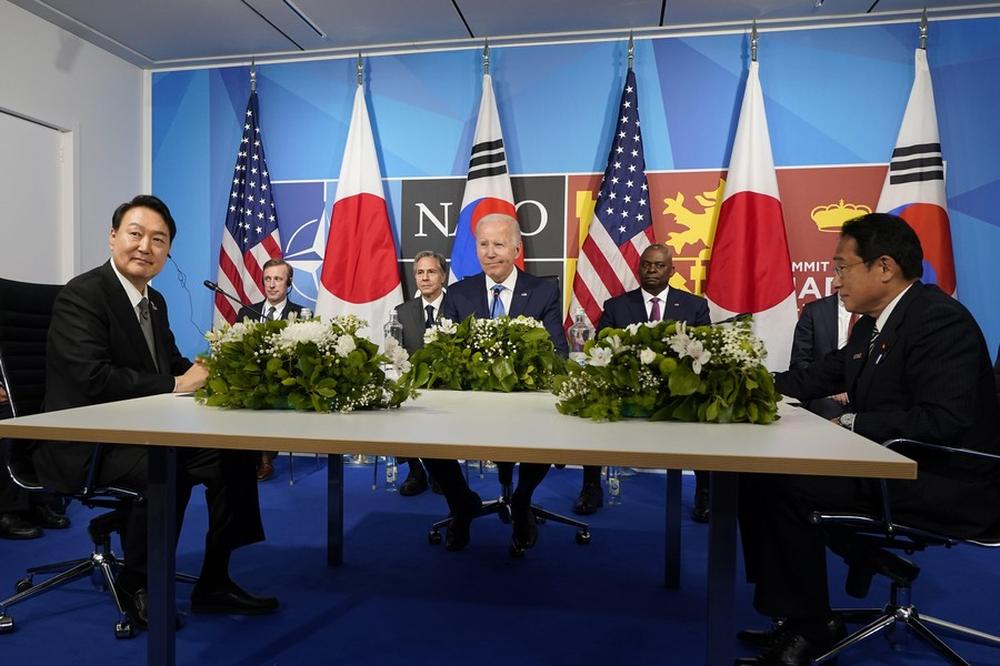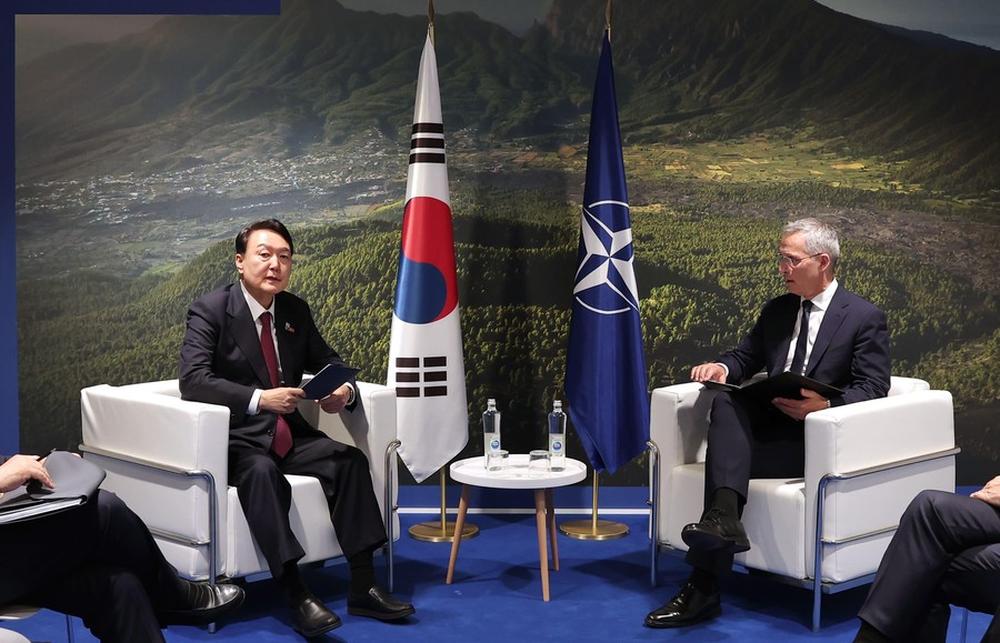- #Europe
- #Global Issues
- #US Foreign Policy

► The Madrid NATO Summit showed two tectonic convergences: (1) between security and economic policy; and (2) between the Atlantic and Pacific policy theaters.
► The 2022 Madrid NATO summit may be more important for what it shows rather than for what it said. Economic and security issues are now inseparable, as are Pacific and Atlantic interests.
► The Madrid Summit may point towards an emerging structure that will identify and implement those areas of agreement, and a venue in which to constructively work through disagreements.
It seems hasty to declare any recently concluded summit meeting as “historic”; history is determined more by consequences than by stated intentions. It is safe to judge, however, that the June 2022 Madrid NATO Summit has the potential to be historic. It welcomed Finland and Sweden as new members, further consolidating Europe; declared Russia to be the premier threat to the alliance rather than a potential partner; addressed the People’s Republic of China (PRC) for the first time in a NATO Strategic Concept paper, calling it “a challenge to our interests, security, and values”; and, not least, welcomed for the first time the heads of government of the Republic of Korea, Japan, Australia, and New Zealand to a NATO summit.
Looking beyond the details—although the details are well worth studying—the Madrid NATO Summit showed two tectonic convergences: (1) between security and economic policy; and (2) between the Atlantic and Pacific policy theaters. These are not overnight developments, nor are they complete, but the Madrid Summit made them manifest.
Regarding the first convergence, that of economic and security policy, liberal democracies used to consider their job as being to protect the space in which the free market could freely operate. Governments might provide necessary regulation or incentives to key industries, but decisions were left to the market. The goal of trade negotiators was to make the international marketplace mirror their free domestic markets, just on a bigger scale. Now, access to semiconductors and protection of digital networks are viewed as core, national security interests, overshadowing everyone’s previous fixation with merchandise trade imbalances. Economic discussions that used to be carried out by trade negotiators are now within the scope of national security actors. This is nowhere more evident than in the relationship between the EU and NATO.
Not long ago, NATO and the EU used to exist in different worlds, even though they are both headquartered in Brussels. For decades following their founding, NATO was responsible for security issues; the EU for economic policy. They did not describe areas of mutual interest until a 2016 Joint Declaration. Now, they are increasingly intertwined. The EU attended the Madrid NATO Summit, as it has every recent NATO summit. A reasonable estimate might be that today 30 percent of the EU’s activity regards security, and 30 percent of NATO’s efforts relate to economic issues.
NATO continues to assert that its focus is on the security of the Euro-Atlantic area, but the NATO 2022 Strategic Concept, released in Madrid, is replete with references to climate change, cyberspace, energy supplies, supply chains, economic coercion, and control of technological sectors. Are those economic or security issues? A reasonable answer is “both” and that puts them within the scope of both NATO and the EU, and within both the United States’ and Korea’s respective national security and economic establishments. The distinction between economic and security policy began to disappear when international trade evolved from boxes carried in boats to data being carried on digital networks. Particularly outmoded is the idea that the Republic of Korea could look to the United States for security and China for trade. Security and trade are no longer separable.
The other convergence that was demonstrated at the Madrid Summit was between the Atlantic and Pacific policy theaters. We are used to thinking of the world in oceanic rather than hemispheric terms. Europe and Asia exist together in the Eastern Hemisphere while the United States is in the Western Hemisphere, but our geopolitical framework is that of Pacific and Atlantic families of nations. China would prefer that the United States be categorized only as an Atlantic country, but that has not been the case for over a century: it is both an Atlantic and a Pacific nation. Now, Europe and Asia are connecting. That is becoming a conceptual as well as a geographic reality. Seoul physically is considerably closer to Brussels than it is to Washington but how many Koreans or Americans would guess that? It is difficult to change habits of thinking.
The presence of Korea, Japan, Australia, and New Zealand at the Madrid NATO Summit was neither the result of a decision by Europe to try to bring the three countries onto its side, nor of East Asian democracies to enlist European support, nor of the United States to try to construct a grand coalition. What led to the enlarged Madrid NATO summit was a mutual recognition among all of them that they share common interests in a new international economic environment, driven by technological and climate change, and a simultaneous (coincidental?) new challenge to the international order from Russia and China. Democracies face their own internal challenges, but continue to share core interests vis-à-vis challengers to the post-war, rules-based system.
Russia’s military attack against Ukraine has had profound, global, consequences and was the main topic at Madrid. There could not be a bigger change than that between NATO’s 2010 Strategic Concept paper that called Russia its potential partner and the 2022 Strategic Concept, which calls Russia its premier threat. Making clear that NATO is not looking for a quick restoration of relations with Russia following a potential Ukraine diplomatic settlement, the 2022 Strategic Concept says that any change in the NATO-Russia relationship will require Russia to “halt its aggressive behavior and fully comply with international law.” Its invasion of Ukraine has made Putin’s Russia a pariah and that will not change anytime soon. Diplomacy requires a degree of trust and that fact that Putin lied to European leaders in private conversations about his intentions towards Ukraine will make it difficult to restore trust, or diplomacy.
The NATO 2022 Strategic Concept puts distance between the ways it regards Russia and China. It does so physically by placing paragraphs on terrorism and the Middle East and Africa between its last paragraph on Russia in paragraph 9 and its first paragraph on China in paragraph 13. Nevertheless, NATO’s language on China is surprisingly tough, especially when one considers that it is the first time NATO has addressed China in a Strategic Concept document, and that it had to be agreed to by all 30 NATO member states, many of which have important relationships with China.
“The People’s Republic of China’s stated ambitions and coercive policies challenge our interests, security, and values.” “The PRC seeks to control key technological and industrial sectors, critical infrastructures, and strategic materials and supply chains. It uses its economic leverage to create strategic dependence and enhance its influence.” “We will work together, responsibly, as Allies, to address the systemic challenges posed by the PRC to Euro-Atlantic security.”
That is remarkably direct language, softened a bit by NATO’s assurance that, “We remain open to constructive engagement with the PRC.” It seems unlikely that China would agree to a NATO-PRC mechanism for dialogue given its assertions that NATO has no business in Asia, but NATO has made the offer. China, mistakenly, seems to continue to regard the EU and NATO as appendages of the United States, a misperception that led to a frosty April 1, 2022 EU-China summit.
The 2022 Madrid NATO summit may be more important for what it shows rather than for what it said. Economic and security issues are now inseparable, as are Pacific and Atlantic interests. China has expressed concern that the United States has been trying to create an “Asian NATO.” It may now need to concern itself with the actual NATO.
The United States should welcome closer ties between its Pacific and European partners, even if that leads them to find common positions that don’t necessarily comport with those of the United States. The United States, EU, NATO, and the Asian democracies are going to agree on what needs to be done more often than they will disagree. The Madrid Summit may point towards an emerging structure that will identify and implement those areas of agreement and a venue in which to constructively work through disagreements.
Mark Tokola is Vice President of the Korea Economic Institute of America in Washington, DC. He retired as a U.S. Senior Foreign Service Officer with the rank of Minister-Counselor in September 2014. His last posting was as Minister Counselor for Political Affairs at US Embassy London. Previously he had served as Deputy Chief of Mission at the American Embassies in Seoul, Republic of Korea; Ulaanbaatar, Mongolia; and, Reykjavik, Iceland. Among his other postings were two tours at the US Mission to the European Union in Brussels, Minister-Counselor for Economic Affairs at Embassy London, and Economic Counselor at US Embassy The Hague. He also served as Director of the Iraq Transition Assistance Office (ITAO) in Baghdad from 2007-2008. Mr Tokola received the State Department’s Superior Honor Award for his work on implementing the Dayton Peace Accords while serving as Political Counselor in Sarajevo, Bosnia-Herzegovina from 1997-1999. He holds a BA in International Relations from Pomona College in Claremont, California, and an LL.M. in European Community Law from the University of Edinburgh, Scotland. Mr. Tokola serves on the Board of Governors of DACOR: An Organization of Foreign Affairs Professionals, and on the Board of Trustees of the Bacon House Foundation.


